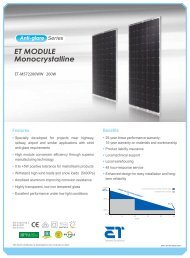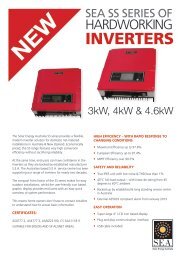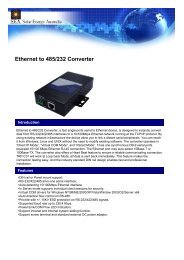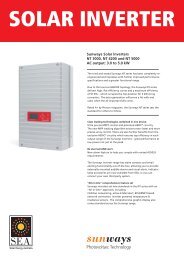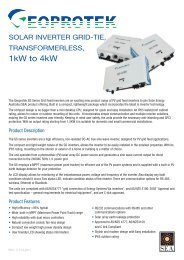Compact Manual 0303 - Solar Energy Australia
Compact Manual 0303 - Solar Energy Australia
Compact Manual 0303 - Solar Energy Australia
Create successful ePaper yourself
Turn your PDF publications into a flip-book with our unique Google optimized e-Paper software.
<strong>Solar</strong> <strong>Energy</strong> <strong>Australia</strong><br />
<strong>Compact</strong><br />
Input current repartition (Power sharing)<br />
To manage the power available on the AC INPUT the COMPACT is<br />
equipped with a system usually called “Power sharing” or INPUT power distribution.<br />
With this feature it is possible to limit the AC INPUT current assigned<br />
to the charger. The more current used by the AC load, the less power<br />
is given to the charger. Priority for the AC Loads. When power sharing is<br />
used the red 200% LED on the power monitor is lit to show that the battery<br />
charging is being limited<br />
Generator<br />
Power<br />
Current<br />
(230V)<br />
500W 2A<br />
900W 4A<br />
1500W 6,5A<br />
2000W 8,5A<br />
3000W 13A<br />
Set the INPUT LIMIT<br />
The current available to the COMPACT depends on the source of the AC input supply, i.e. motor generator, limited grid<br />
supply in a caravan park or shore power. The value of the “INPUT LIMIT” adjustment dial must be lower or equal to the<br />
current available from the AC Input source.<br />
For example if you have a generator of 2kW you must adjust the “Input Limit” to approximately 8.5A. To calculate this,<br />
divide the nominal power of the AC input source (2000W) by the voltage (230V). If the circuit breaker before the COM-<br />
PACT is lower than this value, then you must set the “Input Limit” to the value of the circuit breaker.<br />
Charging current<br />
The maximum charging current for the battery can be adjusted using the “CHARGER” adjustment dial. The charging current<br />
should be set to approximately 10% of the battery capacity (at C10). This means that the charging current for a battery<br />
with 300Ah should be approx 30A.<br />
The charging current is displayed on the “CURRENT MONITOR” on the front panel and on the Remote Display.<br />
Battery condition<br />
The built in microprocessor features a specially developed algorithm<br />
(formulae) which calculates the actual state of charge ( SOC) of the<br />
battery and displays it on LED 15-18. The Equalize LED is lit when<br />
the system is performing an equalization charge.<br />
The SOC displayed should be used as a guide only, for batteries<br />
which are not sealed, use a hydrometer to determine the exact SOC.<br />
For Safety reasons, you must get the recommended charge voltage<br />
and charge current from your battery supplier. The voltage levels<br />
and charge characteristics can be changed through “Programming”.<br />
The correct charging levels are critical for safe functioning and long<br />
life of the battery.<br />
14<br />
15<br />
16<br />
17<br />
18<br />
Equalization cycle<br />
Battery 75 – 100%<br />
Battery 50 – 75%<br />
Battery 25 – 50%<br />
Battery 0 – 25%<br />
The Transfer system<br />
When an AC voltage is present at the AC IN of the COMPACT, the “AC IN” LED is lit. When this voltage matches the<br />
lowest adjusted value set by the “TRANSFER” dial, and the frequency is between 44Hz and 65Hz, then this power is<br />
transferred directly to the AC load and the battery charger section of the <strong>Compact</strong>. The “TRANSFER” LED is lit to indicate<br />
this has happened. The inverter is then switched off and the battery charger switched on. This process is automatic<br />
and should not be noticed by the load, at worst a slight flicker may be seen in lights.<br />
The maximum current of the Transfer switch is 15A. That means through this system, AC loads of up to a maximum 3500<br />
Watts can be operated. When the Battery Charger is working, part of this power is used for the charging according to the<br />
power sharing settings.<br />
The Transfer system is protected against overload with an automatic safety fuse on the AC Input side of the COMPACT.<br />
If the system has been overloaded the button/pin of the fuse will pop-out. To put the automatic safety system back in to<br />
operating you must push this pin back in.<br />
User <strong>Manual</strong> COMPACT Rev 0803<br />
SSC-1601A<br />
Page 13





